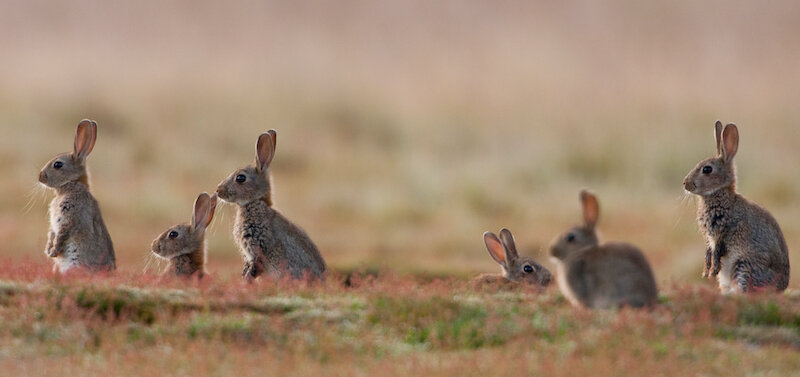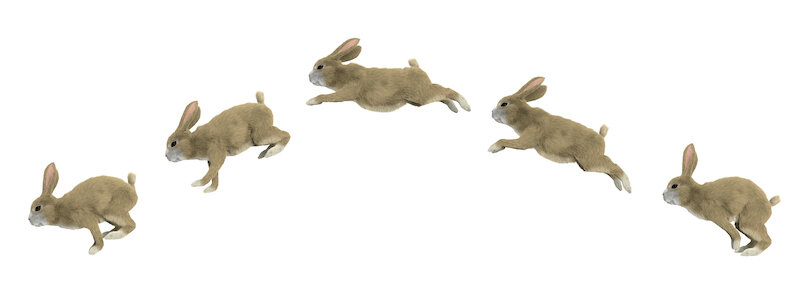Rabbits are cute animals with long ears.
Many people keep them as pets.
Rabbits can run fast and they have big back legs so they can jump far.
Rabbits eat only plants.
Some are wild and some are pets.
Rabbits are small furry mammals. Some people call them bunnies. They are cute, playful animals. There are many breeds (kinds) of rabbit today, but the first ones were tamed from the wild many thousands of years ago, when they were farmed for food.
A male rabbits is a buck.
A female rabbit is a doe.
Young rabbits are kittens.
A group of rabbits is called a colony or herd.
A colony of wild rabbits on the alert, ready to dive down a burrow to safety if needed. Their ears twitch to determine the direction a sound is coming from. ©Getty
Baby rabbits are called kittens ©Getty Images
Wild rabbits
In the wild, groups of rabbits live in a warren, which consists of a number of tunnels and many entrances. They are social animals, and the groups can become very large.
Rabbits groom each other.
Because they move about in dark tunnels, their whiskers are as wide as their body so that they don't get stuck: if the whiskers can fit in the tunnel, they know the rest of their body will too.
Behaviour
Rabbits are most active in the morning and evening, times when they come out of their burrows to feed. This behaviour is called 'crepuscular'.
Rabbits have excellent senses of smell, eyesight and hearing. Their noses twitch constantly as they sniff. They can see almost all around themselves without turning their head.
The movement of a rabbit’s body as it leaps, pushing off on its strong back legs to start. ©Getty
Rabbits run fast, up to about 60 kph. When running at speed, each step they take is a long one. ©Getty
Rabbits have strong back legs, so they can make big jumps. They can jump about a metre high and about 3 metres distance.
They run and jump when they are happy. When they are happy, they 'binky' which is a leap into the air, twisting feet and head and flicking feet.
Rabbits have long ears that can twitch so they can hear sounds from different directions. They stand upright on their hind legs when they need to see some distance to look out for danger. When they see danger, they thump a back leg on the ground to let others know.
A rabbit's teeth never stop growing, and chewing their food helps keep their teeth short. When rabbits are stressed, they shed fur. This is for defence: it is a way of getting free if a predator grabs it.
Rabbits are herbivorous, or plant eaters. ©Getty Images
Diet
Rabbits are herbivores, eating only plants. Because plants are so hard to digest, rabbits produce two kinds of poo. The first is chewed and swallowed again so they can get enough nutrition from the food.
A pet rabbit can be fed dry pellets specially made for rabbits, with the right amount of fibre, and with the right ingredients that won't upset your pet's digestion. Pet rabbits need lots of hay and fresh greens, such as spinach, carrot tops, parsley, some kinds of lettuce but not iceberg lettuce .
Housing your pet rabbit
Pet rabbits can be kept either indoors or outdoors. However, if they live indoors it is best to use pens or gates to keep them in places where they can't chew electrical cords. Rabbits can be trained to use a litter tray. They need a sheltered place where they can go to rest.
A pet rabbits kept outdoors need a hutch that is big enough for the it to run, play and stretch, approximately 3m square. There should be a sheltered area filled with straw where the rabbit can go to rest. The hutch should not be in full sun in hot weather because rabbits can get heat stressed. The hutch needs to be strong and safe: foxes and cats are predators. The hutch should also be rabbit proof against escape - remember that rabbits by nature dig tunnels!
Doe with young ©Getty Images
Life Cycle
About 30 days after mating with a buck, a doe gives birth to between 4 and 12 babies called kittens in a nest that she has lined with fur. They are born blind and without fur. They drink milk from their mother 's body. After a few weeks, the young rabbits have grown fur and can find food for themselves. Rabbits become adults and able to breed after about four months, seven months for bucks.
Wild rabbits at a burrow entrance ©Getty Images
Conservation and Environment
While rabbits can be fun to keep as pets, in the wild, rabbits have caused a great deal of damage in Australia. They still do!
Wild rabbits are a serious pest in Australia. They are not native animals but were brought to the continent by the first British settlers. Just 24 were released into the wild in Victoria about 150 years ago, for the purposes of recreational hunting, because the early settlers wanted to make Australia as similar to England as possible.
The rabbits adapted so successfully that they soon posed a serious threat for many native animals, and still do. They have the same diet as small marsupials such as bandicoots, numbats and others, and live in burrows like they do. Rabbits breed faster and have larger litters of young, and in no time the population of rabbits over-ran the populations of native marsupials, and have eaten a great deal of the native bushland.
They also affect farm pastures by eating the best plants, leaving less nutritious plants for the cattle and sheep. There have in the last hundred years or so been many attempts to get rid of wild rabbits in Australia, including introducing viruses that affect only rabbits and not other animals, including birds that may feed on dead animals.









